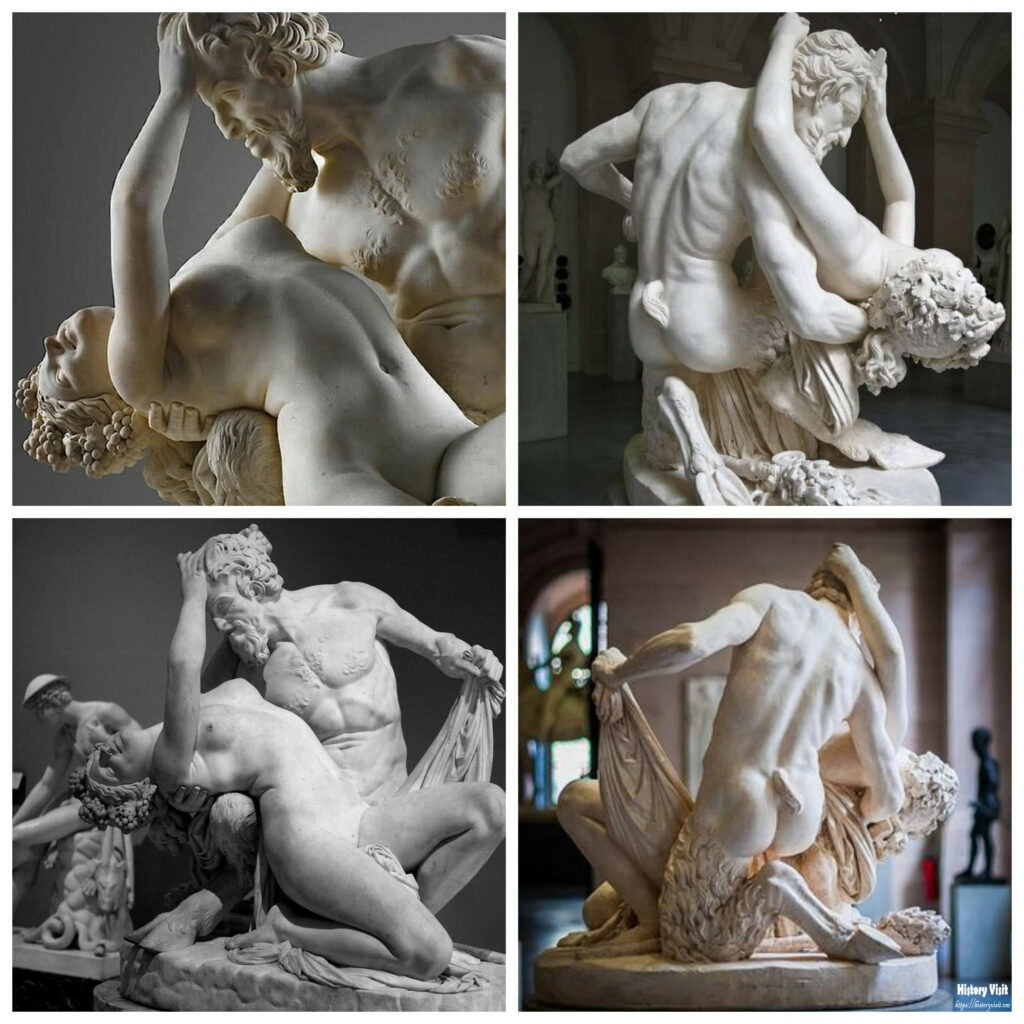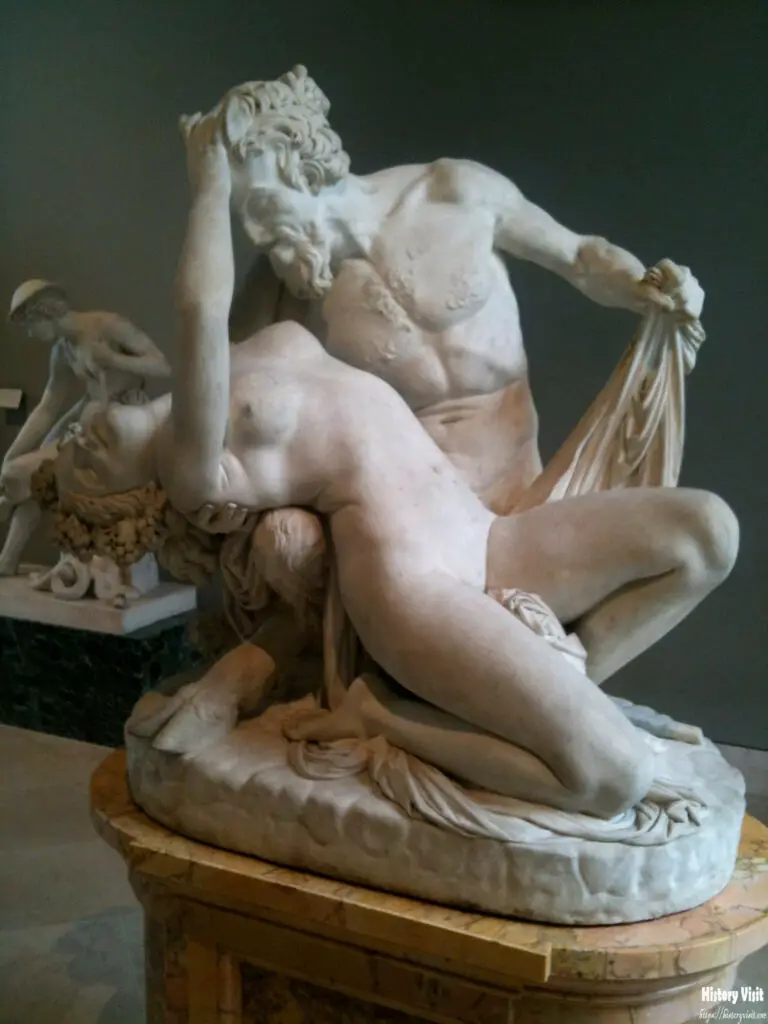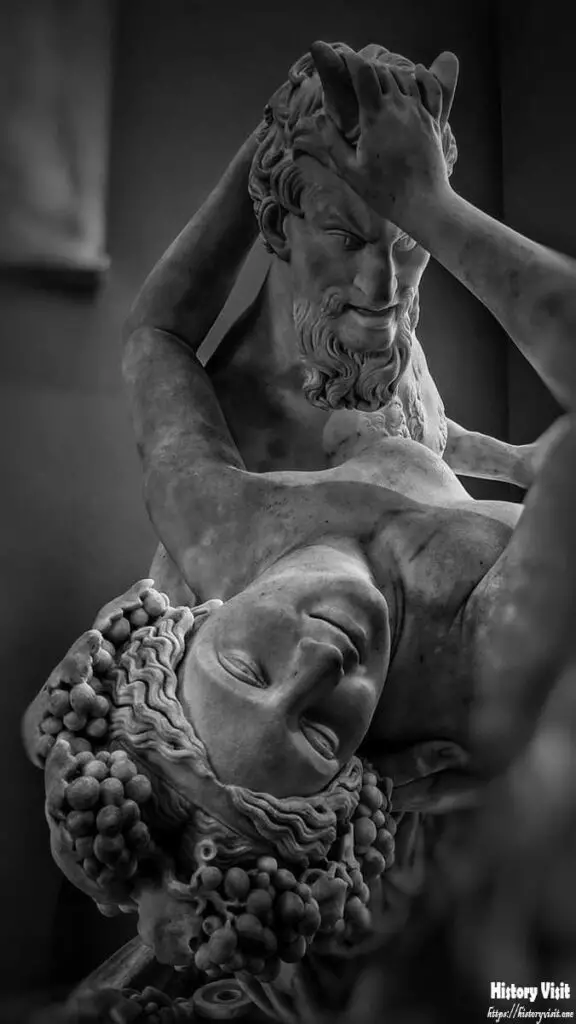The Louvre Statue: “Satyr and Bacchante” by Jean Jacques Pradier

Introduction
The Louvre Museum, an iconic bastion of art and history, houses an extensive collection of masterpieces that have shaped cultural and artistic narratives for centuries. Among its many treasures, the sculpture “Satyr and Bacchante” by Jean-Jacques Pradier stands out as a remarkable example of 19th-century French sculpture. Created in 1834, this marble masterpiece encapsulates the blend of classical mythology and Romantic expressiveness that characterizes Pradier’s work, showcasing his exceptional skill in rendering the human form and conveying profound emotional depth.
Jean-Jacques Pradier, a celebrated sculptor of his time, was known for his ability to infuse traditional classical forms with the passionate intensity of the Romantic era. His work on “Satyr and Bacchante” exemplifies this unique fusion, portraying a dynamic interaction between a satyr and a bacchante. This sculpture not only highlights Pradier’s technical prowess but also delves into rich themes of ecstasy, nature, and the human experience, making it a significant piece in both his oeuvre and the broader context of 19th-century art.
The Artist: Jean-Jacques Pradier
Jean-Jacques Pradier, born in Geneva in 1790, was a pivotal figure in 19th-century French sculpture. His journey into the world of art began at a young age, leading him to the prestigious École des Beaux-Arts in Paris. Pradier’s education at this institution honed his skills and laid the foundation for his future success. His dedication to his craft and his exceptional talent quickly set him apart from his peers, making him a standout student whose works would soon capture the attention of the art world.
Pradier’s rise to prominence was marked by his regular participation in the Salon de Paris, the foremost art exhibition of the time. His works, often inspired by classical themes, were celebrated for their technical mastery and emotional depth. Pradier’s ability to infuse traditional forms with the expressive qualities of the Romantic period earned him a distinguished reputation. His sculptures were not just admired for their beauty but also for their capacity to convey complex human emotions and narratives.
Throughout his career, Pradier remained committed to exploring the human form and its expressive potential. His meticulous attention to detail and his deep understanding of anatomy allowed him to create sculptures that were both lifelike and imbued with a sense of movement. This combination of technical precision and artistic sensitivity made his works stand out in an era that was rich with artistic innovation. Pradier’s sculptures, including “Satyr and Bacchante,” are testaments to his skill and his ability to bring mythological and historical subjects to life.
Pradier’s legacy extends beyond his individual works; he influenced a generation of artists and sculptors who followed in his footsteps. His approach to sculpture, which balanced classical ideals with Romantic expressiveness, helped shape the artistic landscape of the 19th century. Today, Pradier’s works are celebrated not only for their aesthetic qualities but also for their contribution to the development of modern sculpture. His influence is evident in the continued admiration and study of his works by artists, scholars, and art enthusiasts around the world.
The Sculpture: “Satyr and Bacchante”

“Satyr and Bacchante,” created in 1834, is one of Pradier’s most renowned works, exemplifying his ability to merge classical themes with the emotional intensity of Romanticism. The sculpture, crafted from marble, depicts a satyr and a bacchante in a moment of dynamic interaction. The satyr, a mythical creature associated with the god Bacchus, is shown in a playful yet assertive pose, while the bacchante, a female follower of Bacchus, appears receptive yet hesitant, embodying a blend of passion and restraint.
Pradier’s mastery is evident in the intricate details of the sculpture. The satyr’s muscular form and the bacchante’s graceful, flowing lines create a striking contrast that highlights their differing natures. The tension in their bodies and the expressive features of their faces convey a vivid sense of movement and emotion. The careful attention to the textures of their hair, the smoothness of their skin, and the subtle play of light and shadow across the marble surface all contribute to the lifelike quality of the piece.

The composition of “Satyr and Bacchante” is also noteworthy for its dynamic balance. Pradier skillfully arranges the figures in a way that suggests both connection and conflict, capturing the essence of their mythological interaction. The satyr’s forward-leaning posture and the bacchante’s backward tilt create a sense of motion and tension, drawing the viewer into the narrative of the sculpture. This interplay of forms and emotions is a hallmark of Pradier’s work, showcasing his ability to create sculptures that are not only visually stunning but also rich with meaning.
“Satyr and Bacchante” has been admired for its artistic and technical achievements since its creation. It reflects Pradier’s deep engagement with classical mythology and his ability to reinterpret these timeless stories through the lens of 19th-century sensibilities. The sculpture remains a significant piece in the collection of the Louvre, where it continues to captivate audiences with its beauty and complexity. It stands as a testament to Pradier’s talent and his enduring contribution to the world of sculpture.
Themes and Symbolism

The themes and symbolism in “Satyr and Bacchante” are deeply rooted in classical mythology and resonate with the Romantic era’s fascination with nature, ecstasy, and the human psyche. The satyr and the bacchante, figures drawn from the Dionysian myths, embody the tension between civilization and untamed nature. The satyr, with his animalistic features, represents the primal and instinctual aspects of humanity, while the bacchante, often depicted in a state of divine frenzy, symbolizes the pursuit of ecstasy and transcendence through ritualistic celebration.
This interplay between the characters highlights the complex relationship between reason and passion, a central theme in both classical mythology and Romantic art. The satyr’s aggressive courtship and the bacchante’s simultaneous allure and resistance create a narrative of desire and restraint. This dynamic reflects broader human experiences and emotions, making the sculpture not just a depiction of mythological figures but a meditation on the nature of attraction, conflict, and harmony.

Pradier’s depiction also explores the concept of duality, another key Romantic theme. The contrasting forms and postures of the satyr and bacchante emphasize their differing roles and natures, yet their interaction suggests a deeper connection and interdependence. The satyr’s earthy, robust form contrasts with the bacchante’s ethereal grace, symbolizing the balance between the physical and the spiritual, the mortal and the divine. This duality is a recurring motif in Pradier’s work, reflecting his fascination with the complex interplay of opposites.
The sculpture’s detailed execution further enhances its symbolic depth. The careful rendering of the satyr’s muscular anatomy and the bacchante’s delicate features invites viewers to explore the sculpture from multiple angles, revealing new layers of meaning with each perspective. The nuanced expressions and intricate details draw the viewer into the mythological world, encouraging contemplation of the deeper themes embodied in the figures. Through “Satyr and Bacchante,” Pradier not only pays homage to classical mythology but also engages with the philosophical and emotional currents of his time.
Reception and Legacy

When “Satyr and Bacchante” was first unveiled in 1834, it received considerable acclaim for its artistic excellence and emotional resonance. Critics and art enthusiasts praised Pradier’s ability to capture the dynamism and sensuality of the mythological figures, noting the sculpture’s technical precision and expressive power. The work’s success at the Salon de Paris solidified Pradier’s reputation as one of the leading sculptors of his era, and it was soon recognized as a significant achievement in the field of 19th-century art.
The sculpture’s impact extended beyond its initial reception, influencing contemporary artists and shaping the artistic trends of the period. Pradier’s fusion of classical themes with Romantic expressiveness resonated with a generation of sculptors who sought to explore new dimensions of form and emotion. “Satyr and Bacchante” became a reference point for artists interested in the dynamic portrayal of mythological subjects, inspiring numerous works that sought to emulate its balance of technical skill and narrative depth.

In the years since its creation, “Satyr and Bacchante” has maintained its status as a masterpiece of French sculpture. Its inclusion in the Louvre’s collection has ensured its continued visibility and appreciation by a global audience. Art historians and scholars frequently study the sculpture for its exemplary qualities, examining its place within the broader context of Pradier’s oeuvre and 19th-century art. The piece’s enduring popularity attests to its universal appeal and its ability to speak to audiences across different cultures and eras.
Today, “Satyr and Bacchante” continues to captivate viewers with its beauty and complexity. Its presence in the Louvre allows it to be appreciated by millions of visitors each year, contributing to the museum’s mission of preserving and showcasing humanity’s artistic heritage. The sculpture stands as a testament to Jean-Jacques Pradier’s extraordinary talent and his contribution to the art of sculpture. Its legacy lives on, inspiring new generations of artists and art lovers to explore the rich interplay of form, emotion, and mythology.
Conclusion

“Satyr and Bacchante” continues to captivate and inspire viewers at the Louvre, standing as a testament to Jean-Jacques Pradier’s extraordinary talent and artistic vision. The sculpture’s intricate details and dynamic composition invite audiences to explore the timeless themes of desire, duality, and the tension between civilization and nature. Through this work, Pradier successfully bridges the classical past and the Romantic present, creating a piece that resonates with universal human experiences and emotions.
The enduring legacy of “Satyr and Bacchante” lies not only in its aesthetic appeal but also in its influence on subsequent generations of artists and art enthusiasts. As a significant example of 19th-century French sculpture, it highlights the continued relevance of mythological themes and the expressive potential of the human form. By preserving and showcasing this masterpiece, the Louvre ensures that Pradier’s artistic contributions remain a vital part of the cultural dialogue, inspiring appreciation and reflection among all who encounter this exceptional work.


